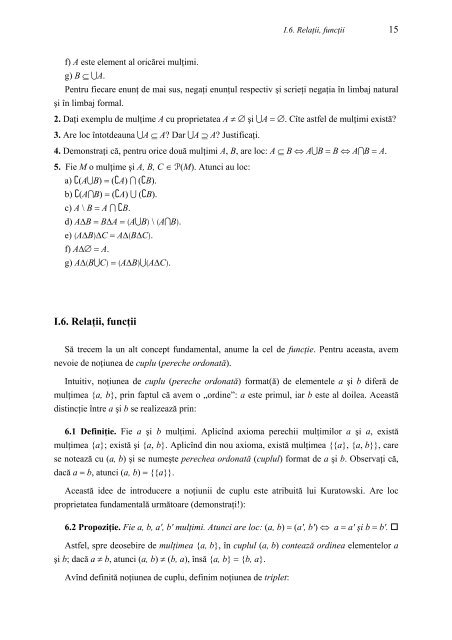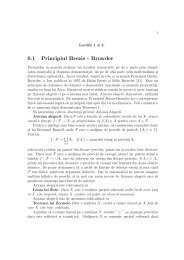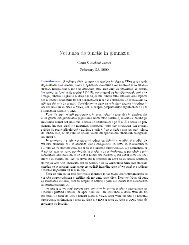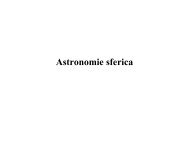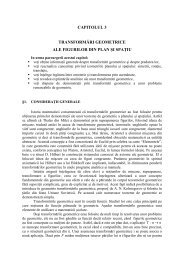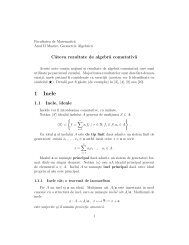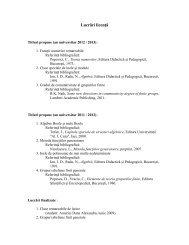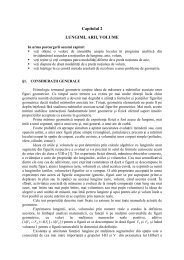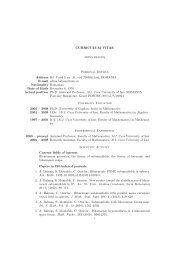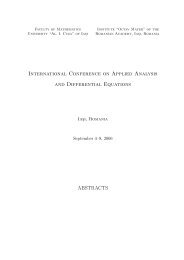Partea a II-a Elemente de teoria mulţimilor şi aplicaţii
Partea a II-a Elemente de teoria mulţimilor şi aplicaţii
Partea a II-a Elemente de teoria mulţimilor şi aplicaţii
You also want an ePaper? Increase the reach of your titles
YUMPU automatically turns print PDFs into web optimized ePapers that Google loves.
I.6. Relaţii, funcţii<br />
f) A este element al oricărei mulţimi.<br />
g) B ⊆ ∪A.<br />
Pentru fiecare enunţ <strong>de</strong> mai sus, negaţi enunţul respectiv <strong>şi</strong> scrieţi negaţia în limbaj natural<br />
<strong>şi</strong> în limbaj formal.<br />
2. Daţi exemplu <strong>de</strong> mulţime A cu proprietatea A ≠ ∅ <strong>şi</strong> ∪A = ∅. Cîte astfel <strong>de</strong> mulţimi există?<br />
3. Are loc întot<strong>de</strong>auna ∪A ⊆ A? Dar ∪A ⊇ A? Justificaţi.<br />
4. Demonstraţi că, pentru orice două mulţimi A, B, are loc: A ⊆ B ⇔ A∪B = B ⇔ A∩B = A.<br />
5. Fie M o mulţime <strong>şi</strong> A, B, C ∈ P(M). Atunci au loc:<br />
a) !(A∪B) = (!A) ∩ (!B).<br />
b) !(A∩B) = (!A) ∪ (!B).<br />
c) A \ B = A ∩ !B.<br />
d) A∆B = B∆A = (A∪B) \ (A∩B).<br />
e) (A∆B)∆C = A∆(B∆C).<br />
f) A∆∅ = A.<br />
g) A∆(B∪C) = (A∆B)∪(A∆C).<br />
I.6. Relaţii, funcţii<br />
Să trecem la un alt concept fundamental, anume la cel <strong>de</strong> funcţie. Pentru aceasta, avem<br />
nevoie <strong>de</strong> noţiunea <strong>de</strong> cuplu (pereche ordonată).<br />
Intuitiv, noţiunea <strong>de</strong> cuplu (pereche ordonată) format(ă) <strong>de</strong> elementele a <strong>şi</strong> b diferă <strong>de</strong><br />
mulţimea {a, b}, prin faptul că avem o „ordine”: a este primul, iar b este al doilea. Această<br />
distincţie între a <strong>şi</strong> b se realizează prin:<br />
6.1 Definiţie. Fie a <strong>şi</strong> b mulţimi. Aplicînd axioma perechii <strong>mulţimilor</strong> a <strong>şi</strong> a, există<br />
mulţimea {a}; există <strong>şi</strong> {a, b}. Aplicînd din nou axioma, există mulţimea {{a}, {a, b}}, care<br />
se notează cu (a, b) <strong>şi</strong> se numeşte perechea ordonată (cuplul) format <strong>de</strong> a <strong>şi</strong> b. Observaţi că,<br />
dacă a = b, atunci (a, b) = {{a}}.<br />
Această i<strong>de</strong>e <strong>de</strong> introducere a noţiunii <strong>de</strong> cuplu este atribuită lui Kuratowski. Are loc<br />
proprietatea fundamentală următoare (<strong>de</strong>monstraţi!):<br />
6.2 Propoziţie. Fie a, b, a', b' mulţimi. Atunci are loc: (a, b) = (a', b') ⇔ a = a' <strong>şi</strong> b = b'. <br />
Astfel, spre <strong>de</strong>osebire <strong>de</strong> mulţimea {a, b}, în cuplul (a, b) contează ordinea elementelor a<br />
<strong>şi</strong> b; dacă a ≠ b, atunci (a, b) ≠ (b, a), însă {a, b} = {b, a}.<br />
Avînd <strong>de</strong>finită noţiunea <strong>de</strong> cuplu, <strong>de</strong>finim noţiunea <strong>de</strong> triplet:<br />
15


